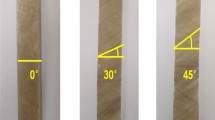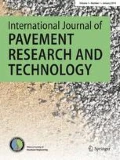Abstract
Many experimental studies have shown that geosynthetic reinforcement of flexible pavement can be beneficial in terms of extending their service life and decreasing the required structural number of the pavement. Although numerous researches have performed experimental and numerical studies to evaluate the benefits of these reinforcements, comprehensive comparisons are lacking among the different investigations. This paper reviews typical field experimental studies on geosynthetic reinforcement of flexible pavement performed by various investigators. Researchers have found that the main appreciable improvement of geosynthetics reinforcement depends on various factors such as subgrade stiffness, base aggregate thickness and quality, hot mix asphalt thickness and quality, geogrid stiffness/location and so on. The granular equivalent (G.E.) factor was determined based on the results of the falling weight deflectometer (FWD) and the results of the unreinforced and reinforced section were compared to obtain the G.E. factors based on mentioned factors of reinforcements. Then, a unique formula is presented in this study, according to the performed comparison of the results. Although more investigations are needed to develop the presented method and general corrections, the results of this study can be used by the designers to evaluate the geosynthetic reinforcement of flexible pavements in their designs as well.
Similar content being viewed by others

References
I. L. Al-Qadi, T. L. Brandon, R. J. Valentine, B. A. Lacina, T. E. Smith, Labtatory evaluation of geosynthetic-reinforced pavement sections, Transp. Res. Rec. 1439 (1994) 25–31.
S. W. Perkins, E. V. Cuelho, Soil-geosynthetic interface strength and stiffness relationships from pullout tests, Geosynth. Inter. 6 (5) (1999) 321–346.
R. R. Berg, B. R. Christopher, S. Perkins, Geosynthetic Reinforcement of the Aggregate Base/Subbase Courses of Pavement Structures, Geosynth. Mater. Assoc., MN, USA, 2000.
M. Saghebfar, M. Hossain, B. A. Lacina, Performance of geotextile-reinforced bases for paved roads, Transp. Res. Rec., 2580 (1) (2016) 27–33.
H. Alimohammadi, M. Abu-Farsakh, Finite Element Parametric Study on Rutting Performance of Geosynthetic Reinforced Flexible Pavements. No. 19-05396. Transp. Res. Board, 98th, Washington DC, USA, 2019.
A. Cancelli, F. Montanneli, In-ground test for geosynthetic reinforced flexible paved roads. N.M.N. United States, 55101-1088. Industrial Fabrics Association International, 1996.
S. W. Perkins, Evaluation of Geosynthetic Reinforced Flexible Pavement Systems Using Two Pavement Test Facilities. No. FHWA/MT-02-008/20040. Montana. Dept. of Transportation. Research Bureau, MT, USA, 2002.
M. Abu-Farsakh, S. Hanandeh, L. Mohammad, Q. Chen, Performance of geosynthetic reinforced/stabilized paved roads built over soft soil under cyclic plate loads, Geotext. Geomemb. 44 (6) (2016) 845–853.
F. Moghaddas-Nejad, J. C. Small, Effect of geogrid reinforcement in model track tests on pavements, J. Transp. Eng. 122 (6) (1996) 468–474.
M. D. Nazzal, M. Y. Abu-Farsakh, L. N. Mohammad, Numerical analyses of geogrid reinforcement of flexible pavements, in GeoCongress 2006: Geotechnical Engineering in the Information Technology Age, Atlanta, GA, USA, 2006, pp. 232.
R. M. Koerner, Designing with Geosynthetics. Published by Prentice Hall, A Division of Simon & Schuster, Eaglewood Cliffs, NJ, USA, 1997.
S. W. Perkins, B. R. Christopher, E. L. Cuelho, G. R. Eiksund, C. S. Schwartz, G. Svanø, A mechanistic-empirical model for base-reinforced flexible pavements, Inter. J. Pavement Eng. 10 (2) (2009) 101–114.
E. V. Cuelho and S. W. Perkins, Geosynthetic subgrade stabilization — Field testing and design method calibration, Transp. Geotech. 10 (2017) 22–34.
S. W. Perkins et al., Development of design methods for geosynthetic reinforced flexible pavements, Report No. DTFH61-01-X-00068. Federal Highway Administration, Washington D.C., USA, 2004.
M. Y. Abu-Farsakh, Q. Chen, Evaluation of the Base/Subgrade Soil under Repeated Loading: Phase II- In-Box and ALF Cyclic Plate Load Tests, Final Rep. — FHWA/LA.10/471, Louisiana Transportation Research Center, LA, USA, 2012.
S. W. Perkins, Geosynthetic Reinforcement of Flexible Pavements: Labratory Based Pavement Test Sections, Report No. FHWA/MT-99-001/8138. Montana Department of Transportation, Helena, MT, USA, 1999.
I. L. Ai-Qadi, A. K. Appea, Eight-Year Field Performance of Secondary Road Incorporating Geosynthetics at Subgrade-Base Interface, Transp. Res. Rec. 1849 (1) (2003) 212–220.
R. Tavakoli et al., Magnetizable concrete composite materials for road-embedded wireless power transfer pads, 2017 IEEE Energy Convers. Congr. Expo. ECCE 2017, Cincinnati, OH, USA, 2017, pp. 4041–1048.
A. Malakooti, M. Maguire, R. J. Thomas, Evaluating Electrical Resistivity as a Performance based Test for Utah Bridge Deck Concrete (CAIT-UTC-NC35), Rutgers Univ. Cent. Adv. Infrastruct. Transp., NJ, USA, 2018.
I. AlQadi, H. Wang, Pavement Damage Due to Different Tire and Loading Configurations on Secondary Roads, NEXTRANS Project No 008IY01, USDOT Region V Regional University Transportation Center, IL, USA, 2009.
I. AlQadi, P. J. Yoo, Effect of Surface Tangential Contact Stresses on Flexible Pavement Response, in 2007 Journal of the Association of Asphalt Paving Technologists: From the Proceedings of the Technical Sessions, San Antonio TX, USA, 2007.
I. AlQadi, H. Wang, E. Tutumluer, Dynamic analysis of thin asphalt pavements by using cross-anisotropic stress-dependent properties for granular layer, Transp. Res. Rec. 2154 (1) (2010) 156–163.
J. G. Zornberg et al., Validating Mechanisms in Geosynthetic Reinforced Pavements. Report No. FHWA/TX-08/0-4829-1. Texas Dep. Transp, Austin, TX, USA, 2008.
J. G. Zornberg, Advances in the Use of Geosynthetics in Pavement Desig, Second Natl. Conf. Geosynth., India, 2011, pp. 3–21.
Þ. Sævarsdóttir, Performance Modelling of Flexible Pavements Tested in a Heavy Vehicle Simulator, (Dissertation). Corpus ID: 173174098. University of Iceland, Reykjavik, 2014.
Guide for Mechanistic-Empirical Design of New and Rehabilitatioed Pavement Structures, NCHRP (ARA, Inc., ERES Division, IL, USA, 2004.
H. Alimohammadi, A framework for evaluation of existing pavement conditions and selection of feasible maintenance/rehabilitation alternatives; a case study in some routes of Livingston Parish in the state of Louisiana, S.N. Appl. Sci. 2 (2) (2020) 289.
J. G. Zornberg, Functions and Applications of Geosynthetics in Roadways, Procedia Eng. 189 (2017) 298–306.
The Best Geosynthetic for Pavement Separation/Stabilization (Civil + Structural Engineer magazine, E019) https://csengineermag.com/the-best-geosynthetic-for-pavement-separation-stabilization/. Accessed 6 January 2020.
American Society for Testing and Materials, Determining the aperture stability modulus of geogrids (standardization of ASM test method in progress by ASTM. ASTM WK24635. Am. Soc. Test. Mater. ASTM, West Conshohocken, PA, USA, 2011.
E. M. Palmeira, I. A. G. Góngora, Assessing the Influence of Some Soil-Reinforcement Interaction Parameters on the Performance of a Low Fill on Compressible Subgrade. Part I: Fill Performance and Relevance of Interaction Parameters, Inter. J. Geosynth. Gr. Eng. 2 (1) (2016) 1–17.
S. L. Webster, Geogrid reinforced base courses for flexible pavements for light aircraft: test section construction, behavior under treffic, laboratory tests, and design criteria, U.S. Army Corps of Engineers, Waterways Experiment Station, Vicksburg, MS, USA, 1993.
S. Maxwell, W. Kim, T. B. Edil, C. H. Benson, Effectiveness Of Geosynthetics In Stabilizing Soft Subgrades. PROGRAM #0092-45-15. Wisconsin Highw. Res., WI, USA, 2005.
M. S. Hossain and Benjamin Neale Schmidt, Benefits of Using Geotextile Between Subgrade Soil and Base Course Aggregate in Low-Volume Roads In Virginia, Brain Res. Report No.: VTRC 10-R1. VA, USA, 2009.
X. Tang, M. Abu-Farsakh, S. Hanandeh, and Q. Chen, Use of geosynthetics for reinforcing/stabilizing unpaved roads under full-scale truck axle loads, Shale Energy Eng. No. 591-602, Pittsburgh, PA, USA, 2014.
K. Rajagopal, S. Chandramouli, A. Parayil, K. Iniyan, Studies on geosynthetic-reinforced road pavement structures, Inter. J. Geotech. Eng. 8 (3) (2014) 287–298.
S. H. Mousavi, Experimental and Numerical Investigation of the Performance of Geosynthetics-Reinforced Unsaturated Subgrade Soils under Cyclic Loading, Raleigh, North Carolina, USA, 2016.
S. Hanandeh, M. Abu-farsakh, L. Mohammad, Q. Chen, and M. Saghebfar, Full-Scale Accelerated Load Testing of Geosynthetics Reinforced / Stabilized Paved Roads built over Native Soft Subgrade, 3rd Pan-American Conf. Geosynth., Miami, FL, USA, 2016.
J. Siekmeier, J. Casanova, Geogrid Reinforced Aggregate Base Stiffness for Mechanistic Pavement Design. Report No.: MN/RC 2016-24. Minnesota Dep. Transp., St. Paul, MN, USA, 2016.
S. W. Perkins, M. Ismeik, A synthesis and evaluation of geosynthetic-reinforced base layers in flexible pavements:part I, Geosynth. Inter. 4 (6) (1997) 549–604.
S. W. Perkins, B. R. Christopher, E. L. Cuelho, G. R. Eiksund, C. S. Schwartz, G. Svanø, A mechanistic-empirical model for base-reinforced flexible pavements, Inter. J. Pavement Eng. 10 (2) (2009) 101–114.
S. W. Perkins, Numerical Modeling of Geosynthetic Reinforced Flexible Pavements, FHWA, Washington DC, USA, 2001, p. 112.
J. Leng, M. A. Gabr, Characteristics of Geogrid-Reinforced Aggregate Under Cyclic Load, Transp. Res. Rec. 1786 (1) (2002) 29–35.
S. L. Webster, Alford, Analysis of grid cell reinforced pavement bases, U. S. Army Eng. Report No. GL-79-8, Vicksburg, MS, USA, 1978.
American Association of State Highway and Transportation Officials, AASHTO guide for design of pavement structures, Am. Assoc. State Highw. Transp. Off., AASHTO, Washington DC, USA, 1993.
Nader Ghafoori, M. Sharbaf, Use of Geogrid for Strengthening and Reducing the Roadway Structural Sections, Carson City, NV, USA, 2016, pp. 119.
J. Siekmeier, J. Casanova, Geogrid Reinforced Aggregate Base Stiffness for Mechanistic Pavement Design. Report No.: MN/RC 2016-24. Minnesota Dep. Transp., St. Paul, MN, USA, 2016.
R. Hass, J. Walls, R. G. Carroll, Geogrid reinforcement of granular bases in flexible pavements, Transp. Res. Rec. 1188 (1) (1988) 19–27.
J. G. Zornberg, R. Gupta, Geosynthetics in pavements: North American contributions, 9th Inter. Conf. Geosynth. — Geosynth. Adv. Solut. a Challenging World, ICG 2010, Brazil, 2010, pp. 379–400.
J. Leng and M. Gabr, Characteristics of Geogrid-Reinforced Aggregate under Cyclic Load, J. Transp. Res. Board, 1786) 29–35, Washington, D.C., 2003.
Pavement Thickness Design, Iowa State wide Urban Des. Specif., IA, USA, 2013.
MnDOT, Pavement Manual, Minnesota Dep. Transp., p. No. 183, St. Paul, Minnesota, MN, USA,1996.
J. M. Chiglo, Minnesota Department of Transportation, Engineering Services Division Technical Memorandum, Minnesota Dep. Transp, St. Paul, MN, USA, 2013.
S. Hanandeh, Performance Evaluation of Instrumented Geosynthetics Reinforced Paved Test Sections built over weak subgrade using Accelerated Load Testing, Louisiana State Univ., Baton Rouge, LA, USA, 2007.
Acknowledgments
The authors want to show their appreciation to John Siekmeier for his kind help and providing valuable information and FWD test results from the Minnesota Department of Transportation (MnDOT) to use in this study. Also, Mr. Qinglong Tian and Dr. Yuderka Trinidad from Iowa State University are thanked for their valuable help in statistical calculations. This manuscript is based upon work supported by MnDOT under contract numbers 1034932 entitled “Effectiveness of Geotextile/Geogrids in Roadway Construction; Determine a Granular Equivalent (G.E.) Factor”.
Author information
Authors and Affiliations
Corresponding author
Additional information
Peer review under responsibility of Chinese Society of Pavement Engineering.
Rights and permissions
About this article
Cite this article
Alimohammadi, H., Schaefer, V.R., Zheng, J. et al. Performance evaluation of geosynthetic reinforced flexible pavement: a review of full-scale field studies. Int. J. Pavement Res. Technol. 14, 30–42 (2021). https://doi.org/10.1007/s42947-020-0019-y
Received:
Revised:
Accepted:
Published:
Issue Date:
DOI: https://doi.org/10.1007/s42947-020-0019-y



